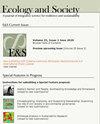A ten-year community reporting database reveals rising coyote boldness and associated human concern in Edmonton, Canada
IF 3.2
2区 社会学
Q1 ECOLOGY
引用次数: 2
Abstract
In cities throughout North America, sightings of coyotes (Canis latrans) have become common. Reports of human-coyote conflict are also rising, as is the public demand for proactive management to prevent negative human-coyote interactions. Effective and proactive management can be informed by the direct observations of community members, who can report their interactions with coyotes and describe the location, time, and context that led to their interactions. To better understand the circumstances that can predict human-coyote conflict, we used a web-based reporting system to collect 9134 community-supplied reports of coyotes in Edmonton, Canada, between January 2012 and December 2021. We used a standardized ordinal ranking system to score each report on two indicators of human-coyote conflict: coyote boldness, based on the reported coyote behavior, and human concern about coyotes, determined from the emotions or perceptions about coyotes expressed by reporters. We assigned greater scores to behaviors where coyotes followed, approached, charged, or contacted pets or people, and to perceptions where reporters expressed fear, worry, concern, discomfort or alarm. Using ordered logistic regression and chi-square tests, we compared boldness and concern scores to spatial, temporal, and contextual predictors. Our analysis showed that coyotes were bolder in less developed open areas and during the pup-rearing season, but human concern was higher in residential areas and during the dispersal season. Reports that mentioned dogs or cats were more likely to describe bolder coyote behavior, and those that mentioned pets or children had more negative perceptions about coyotes. Coyote boldness and human concern both indicated rising human-coyote conflict in Edmonton over the 10 years of reporting.一项为期十年的社区报告数据库显示,在加拿大埃德蒙顿,土狼的胆子越来越大,人们也越来越担心
在整个北美的城市里,郊狼(Canis latrans)的目击已经变得很常见。关于人与土狼冲突的报道也在增加,公众对主动管理以防止人与土狼的负面互动的需求也在增加。有效和主动的管理可以通过社区成员的直接观察来实现,他们可以报告他们与土狼的互动,并描述导致他们互动的地点、时间和背景。为了更好地了解可以预测人类与土狼冲突的情况,我们使用基于网络的报告系统收集了2012年1月至2021年12月期间加拿大埃德蒙顿的9134份社区提供的土狼报告。我们使用了一个标准化的顺序排名系统,根据人与土狼冲突的两个指标对每份报告进行评分:土狼的胆大度,基于报道的土狼行为,以及人类对土狼的关注,取决于记者对土狼的情绪或看法。我们给土狼跟随、接近、攻击或接触宠物或人的行为,以及记者表达恐惧、担忧、担忧、不适或警报的感知打分更高。使用有序逻辑回归和卡方检验,我们比较了大胆和关注得分与空间、时间和上下文的预测因子。分析结果表明,在欠发达的开放地区和幼崽繁殖季节,土狼的危险性较高,而在居民区和分散季节,人类对土狼的关注度较高。提到狗或猫的报告更有可能描述更大胆的土狼行为,而提到宠物或孩子的报告则对土狼有更多的负面看法。土狼的大胆和人类的关注都表明,在埃德蒙顿,在过去的10年里,人与土狼的冲突不断加剧。
本文章由计算机程序翻译,如有差异,请以英文原文为准。
求助全文
约1分钟内获得全文
求助全文
来源期刊

Ecology and Society
环境科学-生态学
CiteScore
6.20
自引率
4.90%
发文量
109
审稿时长
3 months
期刊介绍:
Ecology and Society is an electronic, peer-reviewed, multi-disciplinary journal devoted to the rapid dissemination of current research. Manuscript submission, peer review, and publication are all handled on the Internet. Software developed for the journal automates all clerical steps during peer review, facilitates a double-blind peer review process, and allows authors and editors to follow the progress of peer review on the Internet. As articles are accepted, they are published in an "Issue in Progress." At four month intervals the Issue-in-Progress is declared a New Issue, and subscribers receive the Table of Contents of the issue via email. Our turn-around time (submission to publication) averages around 350 days.
We encourage publication of special features. Special features are comprised of a set of manuscripts that address a single theme, and include an introductory and summary manuscript. The individual contributions are published in regular issues, and the special feature manuscripts are linked through a table of contents and announced on the journal''s main page.
The journal seeks papers that are novel, integrative and written in a way that is accessible to a wide audience that includes an array of disciplines from the natural sciences, social sciences, and the humanities concerned with the relationship between society and the life-supporting ecosystems on which human wellbeing ultimately depends.
 求助内容:
求助内容: 应助结果提醒方式:
应助结果提醒方式:


